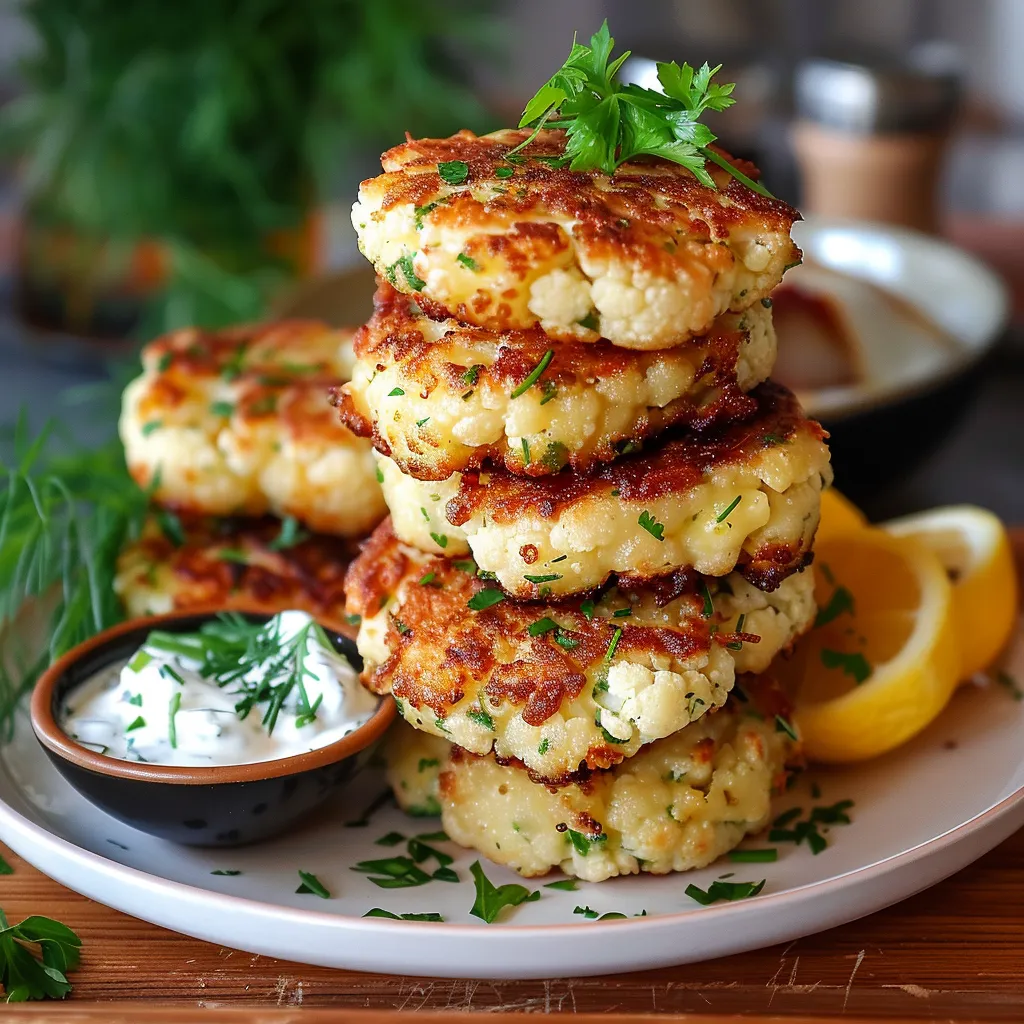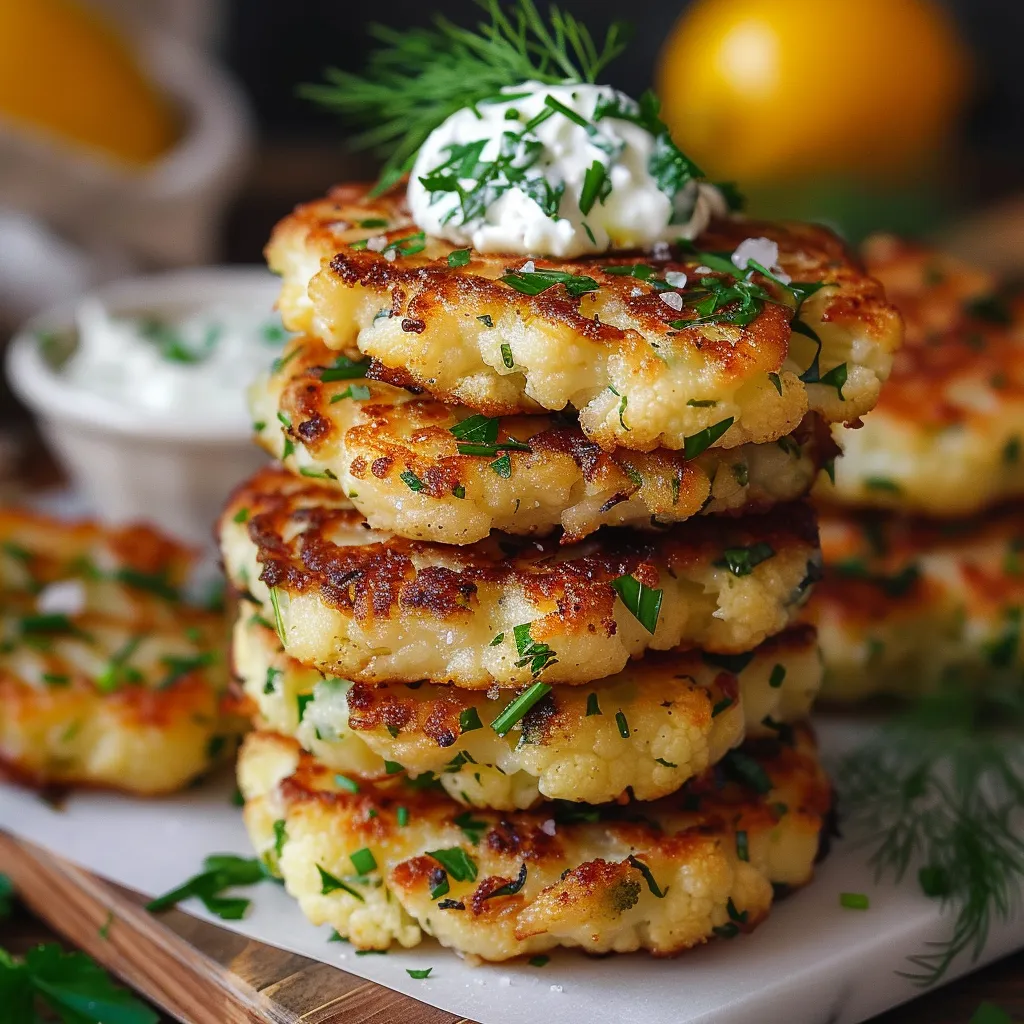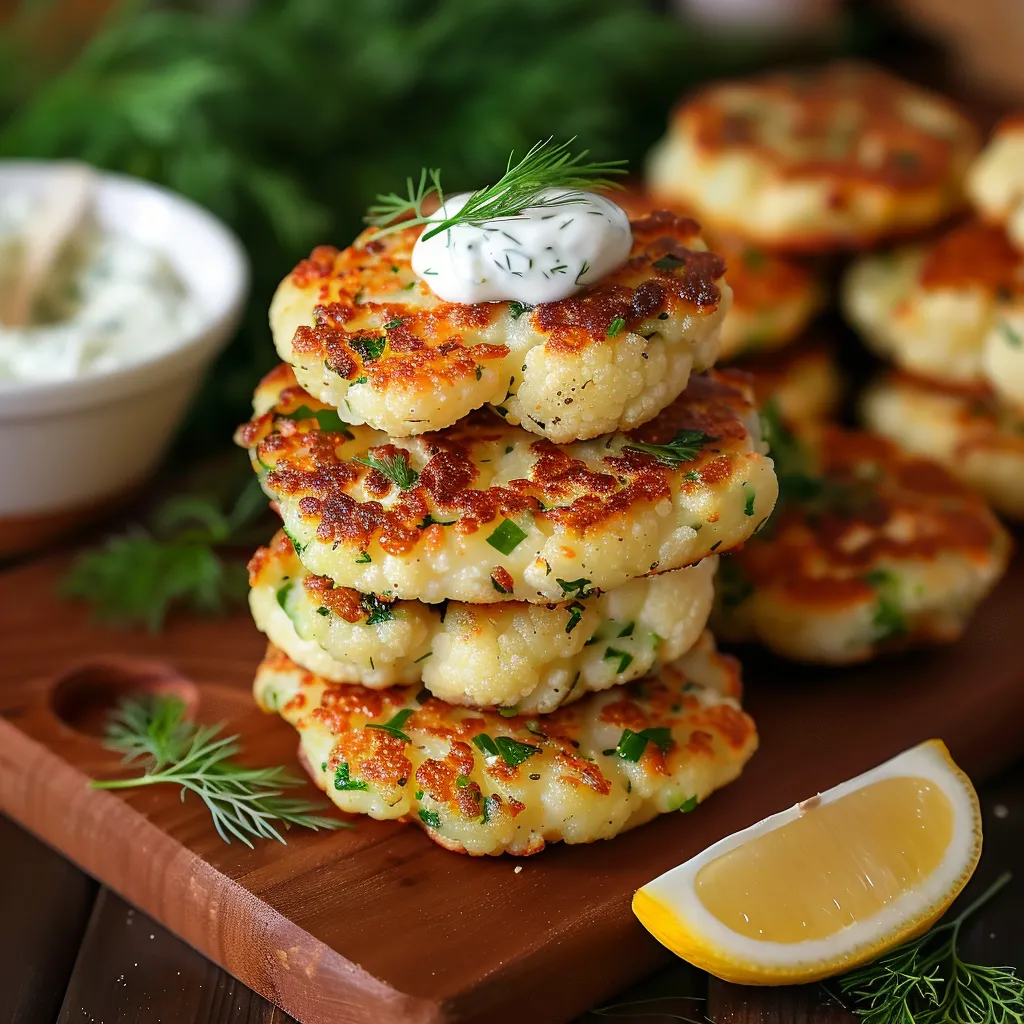 Pin it
Pin it
The moment you bite into these golden Cauliflower Fritters, you're greeted with a perfect contrast of textures – crispy exterior giving way to a tender, savory interior dotted with fresh herbs. This humble vegetable transforms into something truly special when combined with sharp parmesan, fragrant herbs, and a hint of lemon zest. After years of experimenting with cauliflower recipes, I've found these fritters to be the ideal compromise between nutritious and indulgent – substantial enough to satisfy while remaining light enough to leave you feeling energized rather than weighed down.
Last month, I served these at a family gathering alongside grilled chicken. My nephew, who normally pushes vegetables to the side of his plate, asked for seconds and then the recipe. The secret? The perfect balance of texture and flavor that transforms humble cauliflower into something crave-worthy.
Essential Ingredients and Selection Tips
- Cauliflower: Look for a firm, heavy head with tightly clustered florets and vibrant green leaves. Fresh is crucial here, as frozen cauliflower contains too much moisture and will result in soggy fritters. I prefer medium-sized heads which tend to have the sweetest flavor
- Parmesan: Freshly grated parmesan makes a significant difference in both texture and flavor. The pre-grated varieties often contain anti-caking agents that can affect how the cheese melts and incorporates. For vegetarians, a good Italian-style hard cheese makes an excellent substitute
- Fresh Herbs: The combination of parsley and chives adds brightness and complexity. When selecting herbs, look for vibrant color and firm stems. In a pinch, you could substitute with dried herbs (use 1/3 the amount), but fresh really elevates these fritters
 Pin it
Pin it
I've discovered that the lemon zest, though it might seem like a minor ingredient, is actually crucial to the overall flavor profile. It brightens the earthiness of the cauliflower and balances the richness of the cheese and oil. Don't skip this ingredient – it's what makes these fritters special.
Detailed Cooking Instructions
- Prepare the Cauliflower Perfectly:
- Begin by trimming your cauliflower into small, even-sized florets, removing any tough stems. Place the florets in a steamer basket or pot of boiling water and cook for exactly 6 minutes. They should be tender enough to crush but not so soft that they're falling apart. Immediately drain thoroughly and allow the excess steam to evaporate for a minute or two. This prevents excess moisture from making your fritters soggy. I sometimes spread the drained cauliflower on a clean kitchen towel to absorb any lingering moisture.
- Create the Ideal Texture:
- Transfer the drained cauliflower to a large mixing bowl and use a potato masher to crush it lightly. The goal is a consistency similar to small gravel – not a smooth puree. You want varied texture with some pieces being more crushed than others. This inconsistency creates little pockets of cauliflower flavor throughout the fritters and contributes to their perfect texture. Avoid over-mashing, which can make the fritters dense rather than light and crispy.
- Build Layers of Flavor:
- To your crushed cauliflower, add 1/2 teaspoon each of salt and pepper, the zest of one lemon, a small bunch each of chopped fresh parsley and chives, 1 minced garlic clove, 1/2 cup of flour, 1/2 cup of freshly grated parmesan, and 1 medium egg. Mix everything together with a wooden spoon, folding gently from the bottom up rather than stirring aggressively. This preserves the texture variations in the cauliflower. The mixture should hold together when squeezed but still maintain some lightness. If it seems too wet, add an additional tablespoon of flour.
- Form Uniform Patties:
- With clean hands, scoop a heaped tablespoon of the mixture. Roll it gently between your palms to form a ball, then flatten it to about 1/2-inch thickness. Place on a plate and continue with the remaining mixture. You should get 8-10 fritters, depending on the size of your cauliflower. For even cooking, try to make all fritters approximately the same size and thickness. If the mixture sticks to your hands, lightly moisten your palms with water or a bit of olive oil.
- Master the Frying Technique:
- Heat 3 tablespoons of olive oil in a large, heavy-bottomed frying pan over medium heat. The oil should shimmer but not smoke. Working in batches to avoid crowding (which would steam rather than fry the fritters), carefully place 4-5 fritters in the hot oil. Cook undisturbed for 3-4 minutes until the bottom develops a deep golden-brown crust. Flip once with a thin spatula and cook for another 3-4 minutes. The ideal fritter has a crispy, golden exterior while maintaining moisture inside.
- Maintain Temperature Between Batches:
- As you remove the first batch, place them on a paper towel-lined plate and transfer to a warm oven (about 200°F/95°C) to stay hot while you cook the second batch. Before adding the second batch, assess the oil – if it looks dirty or diminished, carefully wipe the pan with paper towels and add fresh oil, allowing it to heat up properly before continuing. Consistent oil temperature is key to evenly cooked, crispy fritters.
- Serve with Complementary Accompaniments:
- These fritters shine brightest when served immediately with a cooling sauce like tzatziki. The contrast between the hot, crispy fritter and the cold, creamy sauce creates a perfect bite. For presentation, place the fritters on a serving plate, add a dollop of tzatziki on each, and garnish with a small sprig of fresh dill. The bright green against the golden fritter makes for a beautiful presentation that enhances the eating experience.
I learned the importance of proper oil temperature through trial and error. My first attempt resulted in fritters that absorbed too much oil and became greasy because the pan wasn't hot enough. Now I always check by dropping a tiny bit of the mixture into the oil – it should immediately begin to sizzle gently, indicating perfect frying temperature.
Make-Ahead Strategies
These fritters are perfect for meal prep. You can prepare the mixture and form the patties up to 24 hours in advance. Simply cover them with plastic wrap and refrigerate. The chilling time actually improves their texture, allowing the flavors to meld and the patties to firm up. Alternatively, you can cook the fritters completely, cool them, and refrigerate for up to 3 days. Reheat in a 350°F (175°C) oven for about 10 minutes until warmed through and crisp again. The microwave works in a pinch but sacrifices the crispy exterior.
Creative Serving Suggestions
While tzatziki is my favorite pairing, these versatile fritters welcome numerous accompaniments. For a Mediterranean-inspired meal, serve with hummus and a simple Greek salad. For breakfast or brunch, top with a poached egg and a drizzle of hot sauce. They also make excellent "buns" for vegetarian sliders – just add roasted red peppers and a smear of pesto between two fritters. For an elegant appetizer, make mini fritters and top each with a small piece of smoked salmon and a dot of crème fraîche.
Dietary Adaptations
These fritters are naturally gluten-free friendly with a simple substitution of all-purpose gluten-free flour blend for the wheat flour. For a vegan version, replace the parmesan with nutritional yeast (use about 3 tablespoons) and substitute the egg with a flax egg (1 tablespoon ground flaxseed mixed with 3 tablespoons water, left to gel for 5 minutes). The texture will be slightly different but still delicious. For those watching carbs, almond flour can replace the all-purpose flour, though you may need to add an extra egg to help with binding.
Flavor Variations
The basic recipe provides a perfect canvas for customization. For a Spanish-inspired version, add 1/2 teaspoon of smoked paprika and substitute manchego for the parmesan. For Mediterranean flavors, mix in 2 tablespoons of chopped olives and 1 teaspoon of dried oregano. Spice lovers can add a finely diced jalapeño or 1/2 teaspoon of red pepper flakes for heat. One of my favorite variations includes 2 tablespoons of crumbled feta and 1 teaspoon of dried mint for a Greek twist.
I discovered these refinements after making these fritters countless times, including one memorable occasion when I was cooking for a vegetarian friend who claimed to dislike cauliflower. After tasting these fritters, she asked for the recipe, proving that even the most skeptical vegetable avoiders can be converted with the right preparation.
The beauty of these cauliflower fritters lies in their ability to transform a humble vegetable into something truly crave-worthy. They represent that perfect middle ground in cooking – healthful yet satisfying, simple yet sophisticated, and versatile enough to complement almost any meal. Whether you're looking for a light lunch, a substantial side dish, or a vegetarian main course, these golden, herb-flecked fritters deliver delicious results every time.
 Pin it
Pin it
Frequently Asked Questions
- → Can I bake these cauliflower fritters instead of frying them?
- Yes, you can bake these fritters instead of frying. Place them on a parchment-lined baking sheet, brush with olive oil, and bake at 400°F (200°C) for about 20-25 minutes, flipping halfway through, until golden brown on both sides.
- → What can I serve with cauliflower fritters?
- Cauliflower fritters pair beautifully with tzatziki sauce as mentioned in the recipe, but they also go well with yogurt-based dips, hummus, avocado sauce, or a simple squeeze of lemon. They make a great side dish for grilled meats or fish, or can be served with a green salad for a light meal.
- → Can I use different herbs in these fritters?
- Absolutely! While parsley and chives work wonderfully, you can experiment with dill, thyme, basil, or cilantro depending on your preference. Just make sure to use fresh herbs rather than dried for the best flavor and texture.
- → Are these fritters gluten-free?
- As written, the recipe contains wheat flour, so it's not gluten-free. However, you can easily substitute the all-purpose flour with a gluten-free flour blend or chickpea flour to make them gluten-free. The texture might be slightly different but they'll still be delicious.
- → Why are my fritters falling apart when cooking?
- If your fritters are falling apart, there may be too much moisture in the cauliflower mixture. Make sure to drain the cauliflower thoroughly after cooking. You can also add an extra tablespoon of flour or refrigerate the formed patties for 30 minutes before cooking to help them hold together better.
